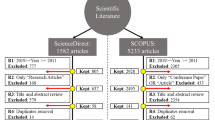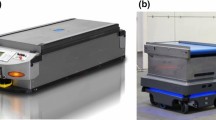Abstract
Cloud manufacturing (CM) is a new type of networked manufacturing model, which is proposed in 2010. Optimization technology is one of the key techniques for CM operation, which are used for the efficient integration of manufacturing resources. In all kinds of manufacturing resources, the machining equipment is one of the most important resources. Using optimization techniques to achieve optimal selection of machining equipment is rarely studied in the CM. In order to handle the optimization selection of machining equipment in CM, comparing with the existing resources optimal configuration, an optimal selection strategy is introduced for the machining equipment in CM. In the selection strategy, first, a multiple objective and binary integer programming model is proposed to describe the optimal selection of machining equipment in CM. Second, after analyzing the mathematical model and the real-world problem of the machining equipment selection in CM, the priority method is adopted to convert the multiple-objective problem into a single-objective problem. Third, an improved particle swarm optimization (IPSO) algorithm based on a novel encoding scheme and fitness function is presented to solve the single-objective mathematical model. Finally, the simulation experiments verify the effectiveness of the IPSO algorithm and show that the selection strategy is more objective and effective to help the client select the machining equipment in the CM than current resources optimization model. This research provides a theoretical support for the development of CM.
Similar content being viewed by others
References
Schmenner RW (2009) Manufacturing, service, and their integration: some history and theory. Int J Oper Prod Manag 29(5):431–443
Li BH, Zhang L, Wang SL, Tao F, Cao JW, Jiang XD, Song X, Chai XD (2010) Cloud manufacturing: a new service-oriented networked manufacturing model. Comput Integr Manuf Syst 16(1):1–16
Cheng SW, Liu XJ (2012) Activity driven industrial design E-service system in cloud manufacturing. Comput Integr Manuf Syst 18(7):1510–1517
Gu XJ, Huang SQ, Chen JX, Yang QH, Fang SL (2012) Cloud manufacturing service platform driven by mold manufacturing industry demand. Comput Integr Manuf Syst 18(7):1650–1657
Li B, Zhang GJ, Shi SX (2012) Mould industry cloud manufacturing platform supporting cooperation and its key technologies. Comput Integr Manuf Syst 18(7):1620–1626
Wu XX, Shi SY, Hou JJ, Yang HC (2012) Aerospace cloud manufacturing service application mode. Comput Integr Manuf Syst 18(7):1595–1603
Ji L, Wang LF, Liao CL (2012) Architecture of automotive electronic cloud manufacturing based on AUTOSAR. Comput Integr Manuf Syst 18(7):1644–1649
Li XB, Yin C, Gong XR, Yin S (2012) Cloud manufacturing service platform for machine tool and processing operation. Comput Integr Manuf Syst 18(7):1604–1612
Tang Y, Li J, Zhang JH (2012) Cloud manufacturing service platform design of closed-loop supply chain oriented to remanufacturing. Comput Integr Manuf Syst 18(7):1554–1562
Zhu LN, Zhao YW, Wang WL (2012) Model of resource package, publication and discovery based on RVCS in cloud manufacturing. Comput Integr Manuf Syst 18(8):1829–1838
Ma C, Sun H-B, Xiao T-Y, Fan W-H, Li L (2012) Novel model-driven joining technology for cloud manufacturing federations. Comput Integr Manuf Syst 18(7):1536–1546
Wang SL, Guo L, Kang L, Li Q, Song WY, Chen G-S (2012) Cloud manufacturing application mode and program analysis. Comput Integr Manuf Syst 18(7):1637–1643
Kilincci O, Onal SA (2011) Fuzzy AHP approach for supplier selection in a washing machine company. Expert Syst Appl 38(8):9656–9664
Zeydan M, Colpan C, Cobanoglu C (2011) A combined methodology for supplier selection and performance evaluation. Expert Syst Appl 38(3):2741–2751
Yucenur GN, Vayvay O, Demirel NC (2011) Supplier selection problem in global supply chains by AHP and ANP approaches under fuzzy environment. Int J Adv Manuf Technol 56(5–8):823–833
PrasannaVenkatesan S, Kumanan S (2012) Multi-objective supply chain sourcing strategy design under risk using PSO and simulation. Int J Adv Manuf Technol 61(1–4):325–337
Wang ZC, Pan XH, Pan XW (2010) Resource service chain construction for networked manufacturing based on ant colony algorithm. Comput Integr Manuf Syst 16(1):174–181
Raheja AS (2002) Reactive recovery of job shop schedules—a review. Int J Adv Manuf Technol 19(10):756–763
Li H, Womer K (2012) Optimizing the supply chain configuration for make-to-order manufacturing. Eur J Oper Res 221(1):118–128
Cai J, Wang L, Zhou G (2010) Supply chain coordination mechanisms under flexible contracts. J Syst Eng Electron 21(3):440–448
Jiao J, You X, Kumar A (2006) An agent-based framework for collaborative negotiation in the global manufacturing supply chain network. Robot Com-Int Manuf 22(3):239–255
Lim MK, Zhang Z (2012) A multi-agent system using iterative bidding mechanism to enhance manufacturing agility. Expert Syst Appl 39(9):8259–8273
Sarfaraz AR, Balu R (2006) An integrated approach for supplier selection. 2006 I.E. International Conference on Industrial Informatics, INDIN'06, pp. 463–468
Wang G, Huang SH, Dismukes JP (2004) Product-driven supply chain selection using integrated multi-criteria decision-making methodology. Int J Prod Econ 91(1):1–15
Wang TY, Yang YH (2009) A fuzzy model for supplier selection in quantity discount environments. Expert Syst Appl 36(10):12179–12187
Kawtummachai R, Van Hop N (2005) Order allocation in a multiple-supplier environment. Int J Prod Econ 93:231–238
Kristianto Y, Gunasekaran A, Helo P, Sandhu M (2012) A decision support system for integrating manufacturing and product design into the reconfiguration of the supply chain networks. Decis Support Syst 52(4):790–801
Fatih Tasgetiren M, Pan QK, Suganthan PN, Buyukdagli O (2013) A variable iterated greedy algorithm with differential evolution for the no-idle permutation flowshop scheduling problem. Comput Oper Res 40(7):1729–1743
Moslehi G, Khorasanian D (2013) Optimizing blocking flow shop scheduling problem with total completion time criterion. Comput Oper Res 40(7):1874–1883
Naderi B, Mousakhani M, Khalili M (2013) Scheduling multi-objective open shop scheduling using a hybrid immune algorithm. Int J Adv Manuf Technol 66(5–8):895–905
Yu J-F, Li Y, Yu H-S, Shen Q (2008) Resources optimization deployment in collaborative manufacturing project based on adaptive ant colony algorithm. Comput Integr Manuf Syst 14(3):576–580
Sheikh RH, Raghuwanshi MM, Jaiswal AN (2008) Genetic algorithm based clustering: a survey. Int. Conf. Emerg. Trends Eng. Technol., ICETET, pp. 314–319
Duan HB, Wang DB, Zhu JQ, Huang X-H (2004) Development on ant colony algorithm theory and its application. Control and Decision 19(12):1321–1340
Eberhart R, Kennedy J (1995) New optimizer using particle swarm theory. Proc Int Symp Micromechatronics Hum Sci, pp. 39–43
Shi Y, Eberhart R (1998) Modified particle swarm optimizer. Proc IEEE Conf Evol Comput Proc ICEC, pp. 69–73
Ishaque K, Salam Z (2013) A deterministic particle swarm optimization maximum power point tracker for photovoltaic system under partial shading condition. IEEE Trans Ind Electron 60(8):3195–3206
Ludermir TB, De Oliveira WR (2013) Particle swarm optimization of MLP for the identification of factors related to common mental disorders. Expert Syst Appl 40(11):4648–4652
Nouaouria N, Boukadoum M, Proulx R (2013) Particle swarm classification: a survey and positioning. Pattern Recogn 46(7):2028–2044
Hamta N, Fatemi Ghomi SMT, Jolai F, Akbarpour Shirazi M (2013) A hybrid PSO algorithm for a multi-objective assembly line balancing problem with flexible operation times, sequence-dependent setup times and learning effect. Int J Prod Econ 141(1):99–111
Bean JC (1994) Genetic algorithms and random keys for sequencing and optimization. ORSA J Comput 6(2):154–160
Liu J, Liao W, Guo Y (2008) Sourcing configuration in global manufacturing based on double-link genetic algorithm. Chinese J Mech Eng 44(2):189–195
Author information
Authors and Affiliations
Corresponding author
Rights and permissions
About this article
Cite this article
Wang, Sl., Guo, L., Kang, L. et al. Research on selection strategy of machining equipment in cloud manufacturing. Int J Adv Manuf Technol 71, 1549–1563 (2014). https://doi.org/10.1007/s00170-013-5578-5
Received:
Accepted:
Published:
Issue Date:
DOI: https://doi.org/10.1007/s00170-013-5578-5




